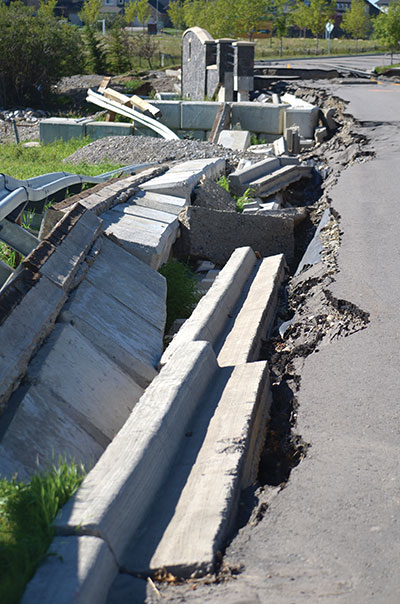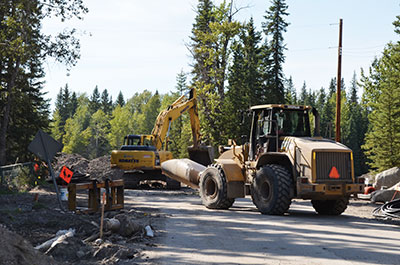
Features
Projects
Roads & Paving
Roads to Recovery
How Alberta rebuilt its road and bridge infrastructure.
February 12, 2014 By Andrew Macklin
It was the costliest natural disaster in Canadian history.
It was the costliest natural disaster in Canadian history. The storm that dumped over 200 millimetres of rain in less than 48 hours on the saturated ground of towns and cities throughout southern Alberta in June 2013 caused close to $6 billion in damages.
 |
|
As the waters rose and flooded the region, the Alberta government responded immediately to help those affected and to minimize damage, while working on a short- and long-term recovery plan. That plan included input from the Alberta Ministry of Transportation, one of the departments that would be counted on in the early days of the recovery to reconstruct important links to allow materials and supplies to reach those in need and to help get people out of the affected areas.
In the beginning
As the waters rose and flooding was imminent, the Ministry of Transportation did its best to monitor the province’s road and bridge infrastructure. Operations manager Fred Lee was on the ground, sending reports twice a day to key ministry staff that provided an overview of the status of the primary roads and bridges in the affected areas. As it became evident which ones were being affected by the storm, staff was able to prioritize where they could help mitigate damage and where the recovery and rehabilitation operations should start once crews could get on the ground.
“It was pretty obvious where we had to focus our efforts,” explains Jason Russell, a bridge engineer for Alberta’s Ministry of Transportation.
The flooding began on Thursday, June 20, leading to dozens of road closures, which were handled by Alberta Transportation staff and contractors. But it wasn’t until Saturday, June 22, that the Alberta government was able to get a full assessment of the damage that had been done and work crews onto the priority job sites.
“By Saturday we basically knew what we had to deal with in the flooded regions,” says Russell, adding that the flood waters took two more days to cross the southern half of the province. “We had a really good inventory.”
The initial work focused on two particular roads, Highway 1 just outside of Banff National Park and Highway 40 in Kananaskis Country. The damage to Highway 1 (Trans-Canada Highway) was preventing traffic from flowing west to east through the Rocky Mountains and Banff National Park, while the extensive destruction to Highway 40 in Kananaskis Country, particularly the washed out crossing at Evan Thomas Creek, had trapped 1,200 staff and campers at several locations, including Peter Lougheed Provincial Park.
“We had to open the highways in stages,” explains Russell. “For example, the first thing we did on Highway 1 outside of Banff National Park was open a single lane in each direction where gaping holes were created by raging flood water.”
Despite significant flood damage, the tireless efforts of the highway’s maintenance contractor, Volken Stevin, allowed a lane in both westbound and eastbound lanes) to open within six days of the disastrous flooding, allowing desperately needed resources and manpower to flow in and out of the region.
Crews worked virtually non-stop as soon as the water receded enough to begin repairs and, just six days later, Alberta Transportation reopened the Trans-Canada Highway.
The highway was returned to four lanes just a few days later.
As for Highway 40, which runs south from Highway 1 east of Canmore, the damage was even more extensive, with most bridges washed out or impassable. Helicopters were already in use to rescue campers from low-lying areas and remote locations but the bulk of campers and staff were accessible by roadway. With the assistance of Canadian military personnel, approximately 800 of the 1,200 people trapped at Peter Lougheed Provincial Park and surrounding campgrounds would be escorted out of the region on roads.
Working together
To get roads and bridges reconstructed quickly in order to access those in need in communities across the province, government ministries, corporations and service organizations had to find a way to efficiently work together.
 |
|
| Crews work on restoring one of the main roads in Bragg Creek, which was one of the towns hit hard when the Elbow River flooded southwest of Calgary.
|
The normal process for getting road and bridge construction work done involves requests for proposal (RFP), preliminary engineering, detailed design, tender preparation and environmental assessments. That process usually takes several months to complete. The floods in Alberta didn’t allow for that time delay.
“We were working based on trust rather than the paper documents we normally use to bind our efforts,” says Russell. “We still used all of the normal best practices for construction that we always use. But not having to write an application, not having to fill out a form or get engineers’ drawings, it made our response very quick.”
There was also less concern over a contractor’s ability to understand the normal best practices needed based on the usual regulatory framework. After all, the contractors involved in the reconstruction efforts had been working with the province’s agencies previously and knew what was required.
“Our contractors knew the construction expectations as well as any environmental requirements and restrictions involved with the work,” says Russell. “And our staff monitored the progress of the flood-related rebuilding.”
Under the traditional regulatory framework, the process of getting the job done would have been about 60 per cent complete by the time the first load of dirt was moved. After the flood, moving the dirt was step 1.
In the first week of the recovery operation, when the priorities were universal, the work got done efficiently and effectively.
“The first week after the flood was probably the most enjoyable week of work I have ever done,” explains Russell, who worked very long days. “For the first week, there was not a single piece of paper issued. It was verbal – conference calls, on site meetings and discussions. We were working and collaborating to determine the best way to resolve the situation.”
The result of the working relationships established between government ministries, contractors and other stakeholders was getting all major roads opened, to some extent, within three weeks of the flood event. Considering the widespread damage throughout the province, and the difficulty in gaining access to some of the roads, the timeline was an incredible accomplishment. This co-operation and focus on the province’s transportation network is another example of the Redford government’s Building Alberta Plan.
“Instead of paperwork creating hurdles, the biggest hurdle was access,” says Russell. “In some cases, you couldn’t get to a bridge because the one before it was still out. This was a physical constraint. We just had to work around those.”
Should flooding of this magnitude ever happen with Canada, at least the work performed by organizations within Alberta has provided a strong case for how best to get our physical infrastructure operational to help rebuild our communities.
By the number to open the Trans-Canada Highway near Banff National Park:
Here’s what it took for Alberta Transportation contractor Volker Stevin to repair the bridges and foundations, clear the culverts and rebuild the roads to open the Trans-Canada Highway just six days after raging flood waters created gaping holes in the roadway:
- 140 workers – 65 on site/75 getting material and equipment to the site
- 13,000 man hours
- 5,500 equipment hours – dozens of pieces of equipment hauling material and working on site
- 175,000 cubic metres of rock backfill
- 850 cubic metres of boulders to stop erosion
- 135 cubic metres of concrete poured to stabilize the bridge abutments
Print this page